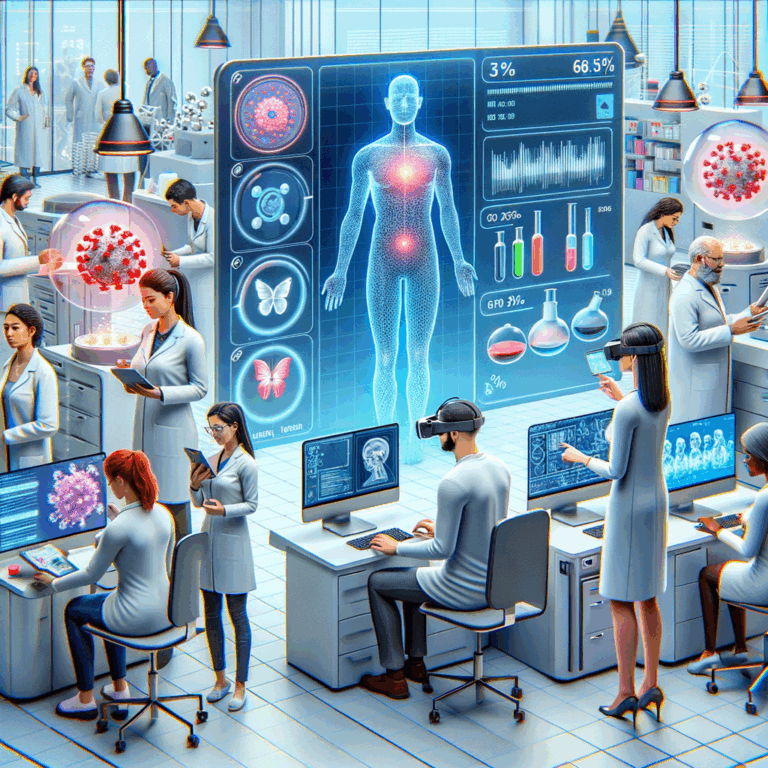When 9 out of 10 drugs fail in clinical trials, after spending billions of dollars, the basic economics of the drug industry require an intervention. The cruel math is unavoidable: each approved drug comes at a cost of $2.6 billion and more than 10 years, while late-stage clinical failures vaporize multiple years of careful bench research in soul-crushing instants of regulatory denial. This flood of capital destruction has created a bottleneck for innovation, where only the most risk-accepting giants can take multiple shots on goal toward therapeutic breakthroughs, while countless promising studies gather dust in the labs and patients wait forever for treatments that will never see the light of day.
Virtual patients—advanced AI simulations that closely mimic human response on a physiological level—show the most promise for the industry to break free from this unsustainable cycle.
And these are not just computational models; they represent a radical reimagining of how drugs are discovered, tested and improved, one that holds the promise of drastically compressing timelines, slashing costs and turning pharmaceutical R&D from an increasingly expensive game of hit-or-miss into a discipline of predictive precision.
Virtual Patients: Redefining Drug Development with AI-Powered Digital Twins
Virtual patients, commonly known as digital twins, are state-of-the-art AI-driven simulations that are very realistic representations of human physiology. These models are trained on large collections of data from the real world, such as patient records, biological processes, treatment responses and survival outcomes from previous clinical trials, allowing them to replicate complex physiological responses in ways that traditional methods are incapable of.
The technology base for these systems includes advanced machine learning architectures (deep neural networks and reinforcement learning) combined with physiologically-based pharmacokinetic (PBPK) modelling frameworks and systems biology principles.
This integration turns what were previously static equations into dynamic biological caricatures that can continue to refine themselves — every clinical confirmation further hones predictive precision through feedback loops, in which updated algorithms can be retrained against ground truth.
The emerging platforms have exceptional predictive power in virtual populations, both demographically and genetically, modelling interactions of drugs with targets, metabolic cascades, and organ-specific responses at the molecular level.
Most importantly, these systems are particularly great at predicting the kind of complex biological events that traditional trials often overlooked: Idiosyncratic adverse events in genetic subpopulations, drug-drug interactions in co-prescription settings, and long-term efficacy patterns that would take decades to verify in human subjects.
This computational prescience turns pharmaceutical decision-making from reactive risk management into proactive outcome engineering, creating the opportunity for researchers to pressure-test therapeutic hypotheses across thousands of virtual patients before a single human subject gets a dose.

Revolutionizing Early Drug Development with Virtual Patients
The early-stage drug development is uncertain, unvalidated biomarkers, sub-optimal dosing and unidentified toxicities can lead to failure of promising candidates. This process is being transformed by virtual patients through the advent of in silico trials, which allow researchers to predict trial failure early, and well before investment in expensive human trials.
These AI-powered simulations mimic the complexity of human biology, making it possible to test thousands of virtual scenarios in a fraction of the time and cost it takes in real life. Stress-testing drug candidates through multiple virtual populations can help scientists find toxicity signals, lack of effectiveness, or off-target effects that would otherwise emerge far later, potentially saving millions in squandered R&D spend.
Furthermore, dose optimization becomes a precision rather than being based on trial-and-error procedures. Thousands of dosing regimens across diverse physiologic and demographic profiles are simulated in virtual models that identify the fine line between efficacy and safety. This methodology contributes to designing first-in-human trials upon which the dosing strategy can be better optimized, avoiding risks of adverse events or ineffective dose.
Even more, virtual patients are able to find safety signals and adverse events in an early phase. They can mimic how populations with rare comorbidities (morbidities that may occur simultaneously with diseases or with druggable comorbidities) or genetic variants or polypharmacy (the use of four or more medications) would respond to drug candidates and unearth risks that would be too rare or too complex to show up in small-scale human trials. This predictive capability reduces the likelihood of late-stage failures, which is when safety problems typically arise at the highest cost.
One of the potentially most dramatic applications of virtual patients is in driving the discovery of biomarkers. Biomarkers are vital in identifying which patients are most likely to benefit from a treatment, but the process of finding and validating them is time-consuming. Analytics: AI-based simulations process massive datasets to unearth possible biomarkers, confirm their predictive values, and optimize the selection of patients for trials. This not only accelerates timelines but also increases the likelihood of success in the trial by starting with the right patients.
Cost-Savings in All Phases of Development – The Virtual Patient’s Economic Potential
Virtual patients are fundamentally changing the economics of drug development, bringing cost efficiencies throughout the entire pipeline. In the pre-clinical phase, the conventional practice of working with animal models and wet-lab experimentations is giving way to in silico simulations, where identification of likely failures can be done on AI-based virtual screening and hence minimizes the need for expensive bench work and animal trials.
This method accelerates pre-clinical operations, reducing costs by 30–50% as seen in industry reports widely published from studies such as those conducted by the Tufts Center for the Study of Drug Development.
For Phase I trials, in which there is frequent amendment of the clinical protocol because of unexpected safety or dosing issues, virtual patients can facilitate accurate simulation of the dosing schedule and cohort design before the commencement of a trial. This forward optimization can have a profound effect in reducing expensive amendments (which typically cost millions associated with trial re-designs and delays).
In phase II and III clinical trials, the two most expensive phases of drug development, virtual patients enable trialists to cut down on size and “real-world” scope of conventional trials and still meet statistical power, or even regulatory conditions. Using thousands of patient simulations, such portal helps in identifying a biomarker-driven subset of populations and consequently facilitates targeted trials requiring less number of patients and shorter follow-up time.
This minimizes the necessity for large multi-centre studies, which fall among the most expensive elements of drug development. In regulatory filings, virtual patient simulations deliver strong, AI-validated data sets that supplement trial data, resulting in quicker approvals and decreasing time and cost spent on re-filings or more studies. The FDA, EMA and other regulatory bodies are seeking to do more to incentivize model-informed drug development (MIDD), creating an environment in which virtual patient data can be a possible cornerstone of submission dossiers.
By using virtual patients throughout these stages, biopharma companies can not only save costs but also fast-track their timelines, improve R&D productivity and limit the financial risk of drug development.
Addressing Scepticism: Validation, Accuracy, and the Path to Trust in Virtual Patients
Although there is no doubt about the transformative potential virtual patients offer, the challenge of scepticism around their reliability still needs rigorous validation, careful regulatory context work, and most importantly, continuing transparency and improvements.
At the forefront of this aspect is, of course, the validation, where virtual patient models must be continuously validated against clinical trial data and compared to clinical trials to ensure their accuracy. This process of comparing simulated performance (i.e, drug efficacy, safety signal, and PK profile) to actual trial results ensures that these models are ever-evolving and increasing in accuracy for their intended use, which adds a feedback mechanism for supporting confidence in their role.
For instance, physiologically-based pharmacokinetic (PBPK) models have proven to be in excellent agreement with the outcomes of Phase I studies, serving as a solid underpinning for wider use.
Regulatory pathways are also changing to formalize simulation evidence as a valid tool. Programs such as the FDA’s Model-Informed Drug Development (MIDD) and EMA’s research around in silico trials are making provision for how to include virtual patient data into submissions. These initiatives are developed to establish best practices, identify permissible use cases, and ascertain that proxy-based (VP) evidence is supplemental to—rather than substitutive for—evidence from traditional trials to address concerns about excessive reliance on simulations.
Just as fundamental is a commitment to transparency. Virtual patient technology developers are becoming more upfront about their model limitations, including in their abilities to predict highly complex, multi-organ interactions or rare adverse events (for which there is little data available). By recognizing these unknowns, the field builds credibility and manages expectations regarding the limits and generalizability of virtual patient simulations.
Lastly, as AI-powered models continue to evolve and learn, these virtual patients become more and more realistic over time. By incorporating real-world information, e.g., post-market surveillance, electronic health records (EHR), and data output from wearables, models can learn and continuously improve (dynamic models), minimizing errors in predictions and broadening their applicability across different populations and therapeutic indications. These successive models then turn into living simulators that mirror and actively contribute to current medical knowledge advancement.
Validation, regulation, transparency, and iterative improvement are driving the industry to confront scepticism head-on, establishing virtual patients as a reliable foundation of the future drug development landscape.
Beyond Cost Savings: The Strategic Advantages of Virtual Patients
The advantages of virtual patients are not only about cost-effectiveness, but also at a strategic level that changes the game of R&D within the pharmaceutical industry. More rapid decision-making is one of the most transformative advantages, in that virtual simulations can be used to make go/no-go calls at earlier points in drug discovery and lead refinement by quickly eliminating non-viable compounds and improving candidates with the best chance of success.
This early filtering minimizes the portfolio risk and diverts investment to more promising programs, enhancing the productivity of R&D in a substantial way. Furthermore, patient stratification is transformed by the ability of VPs to model different subgroups, such as different genetic, comorbidity, and demographic profiles. Here, this granularity ensures that clinical trials are focused on the appropriate populations, which helps to increase the probability of success while at the same time decreasing the probability of late-stage failures.
The advantages are also very attractive from an ethical perspective of virtual patient technology. These simulations help avoid the ethical dilemma of traditional drug development, which relies heavily on human and animal testing. The approach could protect rare and vulnerable patient populations from unnecessary exposure in early-phase trials and limit animal testing while remaining scientifically robust, they suggest. Finally, the need for virtual patients is palpable.
By shortening timelines with in silico experimentation, companies can bring to market faster than using traditional means, which is a significant asset in competitive therapeutic areas. Beyond market exposure, virtual patient adoption provides accelerated time for securing patent-protected exclusivity, both of attendant and strategic importance. All of which is to say, virtual patients are much more than a cost-saving innovation—they’re the infrastructure of de-risking, accelerating, and ethically augmenting the future of pharmacology.

Implementation Challenges and Solutions: Paving the Way for Virtual Patients
While the opportunities that virtual patients can bring to pharmaceutical R&D are transforming, doing so is not without its hurdles that need to be navigated strategically.
Data quality will be essential, since the accuracy and the predictive power of virtual patient models hinges on being able to access an extensive library of high-quality, diverse datasets across a full spectrum of genetic, demographic and clinical variables.
To combat this, companies are starting to collaborate with health systems, tapping real-world evidence (RWE) and integrating multi-omic data so that their models include real-world complexity.
Another challenge is the integration of the tool within established processes, as numerous institutions find it difficult to incorporate the virtual patient technology into their traditional workflows. This can be moderated by hybrid models, in which virtual patients supplement – and not replace – existing preclinical and clinical techniques and provide gradual adoption by showcasing clear value supported by experience.
Regulatory considerations further add to the complexity, as evidence from virtual patients generated by the industry will need to reach the same high-bar standards to be acceptable to the FDA or EMA. The active involvement with regulatory agencies under programmes such as the FDA’s Model-Informed Drug Development (MIDD) initiative is critical. To ensure confidence from the regulatory point of view, companies should furnish transparent documentation of model assumptions, validation procedures, and limitations.
At last, the talent competition is key here, as the pharmaceutical industry has an escalating need for AI modelling, systems biology and computational pharmacology. To develop internal talent, companies are heavily investing in cross-disciplinary training programs, partnering with academic institutions, and bringing in experts from AI-heavy industries such as tech and data science.
By tackling these issues directly and instituting forward-thinking solutions to meet them, pharma firms can make the most of virtual patients, successfully integrating this disruptive technology into the drug development life cycle and while staying in sync with regulatory and scientific requirements.
Future Implications for the Industry
The rise of virtual patients indicates a transformative shift in the pharmaceutical R&D world, described by some as a hint at the future of drug development far beyond what we are capable of today.
By simulating drug development in silico, from target confirmation to trial design, the virtual drug development first paradigm is changing the game, allowing pharma organization to make decisions more quickly, based on data and with less reliance on conventional, resource-intensive approaches.
This trend will reshape industry practice and workflows, where speed and efficiency, and early-stage de-risking, are now king. Meanwhile, precision medicine will achieve a level of granularity never before possible with the creation of personalized virtual patients. Combined with single-cell genomics, proteomics and real-world-based data, these simulations will enable the research community to generate more personalized treatment options by targeting smaller groups of patients, thus optimizing the efficacy of therapy while minimizing toxicity.
Most exciting of all is the “democratization of innovation” that virtual patient technology allows. The small biotechs that are frequently strapped for resources can now tap into the efficiency of scalable AI platforms and level the playing field with the big pharma companies. Cloud and low-cost simulation tools bring these companies the latest capabilities and level the playing field, triggering an explosion of new therapies in a variety of therapeutic areas. At the same time, regulatory evolution is preparing the path for virtual patients to play a crucial role in routine drug development.
Regulators like the FDA and EMA are increasingly open to model-informed drug development (MIDD), creating policies about how simulation data may be factored into submissions. This continued convergence in regulation marks a tipping point towards greater AI adoption methods, alignment of regulation and innovation in research.
Together, these developments point to a future in which virtual patients serve not just to accelerate R&D, but also to rewrite pharma’s competitive and regulatory environment — ushering in a leaner, faster, more inclusive era of innovation.
Conclusion
Virtual patients are a disruptive innovation that is going to revolutionize drug development. By utilizing AI-powered tech, pharma firms can bring down costs, expedite timelines, and make decisions at a new level of fidelity—all of which means better patient outcomes and more precise therapies.
As the industry transitions to this new virtual-first operating model, adopting these technologies is no longer a nice-to-have but a necessity to compete and solve for the growing complexity of health care. It is an acceleration of drug development – but also of the transition to patient-centric processes – that will redefine the future of medicine, with more precise, more accessible, more innovative healthcare for patients all around the world.
Found this article interesting?
1. Follow Dr Andrée Bates LinkedIn Profile Now
Revolutionize your team’s AI solution vendor choice process and unlock unparalleled efficiency and save millions on poor AI vendor choices that are not meeting your needs! Stop wasting precious time sifting through countless vendors and gain instant access to a curated list of top-tier companies, expertly vetted by leading pharma AI experts.
Every year, we rigorously interview thousands of AI companies that tackle pharma challenges head-on. Our comprehensive evaluations cover whether the solution delivers what is needed, their client results, their AI sophistication, cost-benefit ratio, demos, and more. We provide an exclusive, dynamic database, updated weekly, brimming with the best AI vendors for every business unit and challenge. Plus, our cutting-edge AI technology makes searching it by business unit, challenge, vendors or demo videos and information a breeze.
- Discover vendors delivering out-of-the-box AI solutions tailored to your needs.
- Identify the best of the best effortlessly.
Anticipate results with confidence.
Transform your AI strategy with our expertly curated vendors that walk the talk, and stay ahead in the fast-paced world of pharma AI!
Get on the wait list to access this today. Click here.
4. Take our FREE AI for Pharma Assessment
This assessment will score your current leveraging of AI against industry best practice benchmarks, and you’ll receive a report outlining what 4 key areas you can improve on to be successful in transforming your organization or business unit.
Plus receive a free link to our webinar ‘AI in Pharma: Don’t be Left Behind’. Link to assessment here
5. Learn more about AI in Pharma in your own time
We have created an in-depth on-demand training about AI specifically for pharma that translate it into easy understanding of AI and how to apply it in all the different pharma business units — Click here to find out more.

